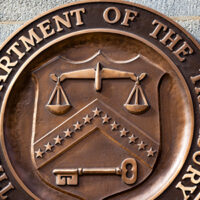
The art market’s vulnerabilities to financial crime have recently become a growing concern in the U.S., Europe and the U.K. Increasingly, authorities have turned their attention to art market transactions, acknowledging that—like other high-end assets—the art trade is ripe for money laundering.1 Scrutiny has been expedited and heightened by the ongoing war in Ukraine. Since the annexation of Crimea in 2014 and following the full-scale invasion of Ukraine in 2022, there has been a groundswell of international criticism of Russia’s aggression. Japan, Canada, the U.S. as well as member states across the European Union (EU) have implemented over 2,500 sanctions,2 frozen assets and reduced the flow of luxury assets in and out of the Russian Federation.3
In February 2023, Bloomberg reported that major U.S. auction houses had been subpoenaed as part of a federal investigation into Russian oligarchs sanctioned by the U.S.4 If true, this art market investigation to identify art owned by sanctioned individuals stands as a remarkable example of scrutiny directed toward collectible property holdings. Dealings of or related to Russian oligarchs reach beyond the sanctioned individuals or entities to concern third parties who may willingly or unwillingly facilitate and abet illicit financial dealings.5
Following the 1991 collapse of the Soviet Union, privatization of national resources and active international trade, including generous incentives to bank overseas and store wealth in offshore jurisdictions, enriched the Russian business elite and made them accustomed to a certain lifestyle, including participating in public auctions and private sales of art and other luxury goods.6 Individuals who have actively participated in art transactions and were subsequently sanctioned include Viktor Vekselberg, brothers Arkady and Boris Rotenberg, Roman Abramovich, Oleg Deripaska and others.7 Once names of these individuals appeared on the Office of Foreign Assets Control’s (OFAC) Specially Designated Nationals (SDN) list, members of the art trade were no longer allowed to receive property on consignment and sell property to these sanctioned individuals.
In addition to the general blanket of prohibition to conduct business with sanctioned individuals seeking to buy or sell artifacts, art is also affected by the broader ban on the sale of luxury goods to Russia and Belarus.8 Scrambling to circumvent sanctions, or in anticipation of being sanctioned, numerous sanctioned individuals transferred their assets to their agents, spouses and children.9 They have also engaged in oddly timed divorces.10 The whereabouts of the collections belonging to these sanctioned individuals are being increasingly scrutinized.11
In June 2023 (through a bipartisan effort in the U.S. Congress), a new amendment was introduced to the State Department Basic Authorities Act of 1956 to encourage whistleblowing that would identify agents looking to enable money laundering and evasion of sanctions.12 The proposed amendment follows a series of indictments, such as the 2022 indictment against the U.K. businessman Graham Bonham-Carter, who was accused of attempting to export a painting owned by Oleg Deripaska from the U.S. by concealing Deripaska’s ownership of the artwork.13
These recent events demonstrate both actions of unscrupulous actors exploiting the vulnerability of the art market and concerted efforts to combat the illicit practices. While the art market is susceptible to money laundering and violating sanctions, art market participants (i.e., individuals or companies that act as dealers or intermediaries, operators of free ports, etc., in the sale, purchase or storage of artworks) can and should take proactive measures to prevent financial crimes.
The Art Market’s Exposure to Financial Crime
According to the U.S. Department of the Treasury report issued on February 2, 2022,14 the global nature of the art market—with its myriad intermediaries and dealers, as well as its reputation for discretion and opacity—has made it an attractive target for individuals looking to launder illicit funds or circumvent sanctions. Criminals are also drawn to the art market’s high-value assets, which can be easily moved and sold across borders, and kept in free ports.15 How can art market participants protect themselves against being used as a conduit for money laundering or against dealing with a sanctioned individual, if they do not know with whom exactly they are dealing?
For the last three decades, the art market has demonstrated a gradual shift toward embracing greater transparency and diligence
According to the United Nations Office on Drugs and Crime (UNODC), “Money laundering is the processing of criminal proceeds to disguise their illegal origin.”16 In the context of the art market, possible money laundering methods include concealing the identity of the true owner, manipulating prices and reporting fictitious transactions. Over- and under-invoicing exemplifies money laundering because it aims to conceal illicit funds being transferred across national borders.
In 2006, Brazilian financier Edemar Cid Ferreira, founder and former president of Banco Santos, was convicted of embezzling funds from his bank and then using the money to purchase art.17 He bought valuable artwork from artists, such as Basquiat, Roy Lichtenstein, Joaquin Torres Garcia and Serge Poliakoff, for a total estimated value of $20 million to $30 million.18 Ferreira attempted to hide his wealth by smuggling art out of Brazil with false documentation, inaccurate valuations and fictitious titles. In one instance, he tried to smuggle a 1981 painting by Basquiat, Hannibal, to New York, valuing it at just $100 in customs claims, when it is currently estimated at $8 million.19
The State of Due Diligence in Today’s Art Market
For the last three decades, the art market has demonstrated a gradual shift toward embracing greater transparency and diligence. Some of its players, especially major auction houses and art fairs, have been relying on a system of self-regulation to mitigate reputational risks and maintain the trust of the public, with many adhering to strict guidelines. As a result, buyers and sellers must rely on the expertise and reputation of dealers, auction houses and other art market professionals to ensure that their transactions are fair and legal.
However, art market participants mainly focus on the question of the object’s authenticity or provenance while disregarding or overlooking the identity of the purported collector or intermediary in the name of sacrosanct discretion. Numerous instances of fraud and forgery in the art market show the importance of thoroughly examining not only the provenance and the background of the artwork but also the individuals connected to the proposed transaction and the conditions of the transaction to ensure its integrity. Consider, for example, the scandals surrounding forgeries sold by the Knoedler Gallery, traded through intermediaries based in Long Island, New York, and Fortuna Fine Arts’ looted antiquities, where a dealership was established by an individual previously implicated in the illicit trade of antiquities and the plundering of cultural heritage.20
Pursuant to the EU directive and specific domestic regulations, art market participants have legal and business obligations to prevent money laundering and avoid violation of sanctions regimes. In the U.K., the obligation to conduct know your customer screening applies to all types of art businesses, including galleries, auction houses, dealers and collectors.21 This is particularly important in the art world, where transactions can involve large sums of money and frequently cross international borders. Failure to do so can result in significant legal and financial consequences, including civil and criminal penalties.22 Individuals and entities may also face reputational damage and other consequences such as being added to government watchlists, restrictions on their ability to conduct business and loss of licenses or permits.
Furthermore, in most countries, anyone, regardless of the industry, is obligated to ensure that they are not unwittingly handling “dirty money” or facilitating, aiding and abetting money laundering activities.23 In the U.S., it is unlawful for “An individual to violate, attempt to violate, conspire to violate, or cause a violation [of]” imposed sanctions; an individual who is involved in said transactions can be held criminally liable.24 Knowledge can be based on willful blindness or deliberate indifference; this manifests itself in the failure to investigate when faced with red flags of illegal activity.25
From Self-Regulation to Government Oversight
Despite the industry’s self-regulating efforts,26 the current global art market is facing growing pressure to comply with anti-money laundering (AML) regulations. In 2020, the European Union introduced the Fifth Anti-Money Laundering Directive (5AMLD), which added art market participants into the EU’s AML and counter-terrorist financing (CTF) regimes. The U.K. has implemented the directive by introducing the Money Laundering and Terrorist Financing (Amendment) Regulations 2019, which went into effect in January 2020.27 In the U.S., the Anti-Money Laundering Act of 2020 (AMLA) amended the Bank Secrecy Act (BSA) to include antiquities dealers, “Including an advisor, consultant, or any other person who engages as a business in the solicitation or the sale of antiquities.”28 AMLA also required the U.S. Department of the Treasury to consider the extent of vulnerability of the rest of the art market to money laundering and to make recommendations on whether and how to regulate the entire industry.29
Under these new or impending regulations, art dealers and galleries dealing with antiquities and/or artworks, depending on the jurisdiction, are subjected to the same obligations as financial institutions (FIs), including reporting and record keeping requirements.30 However, the art market presents unique challenges when it comes to detecting money laundering activities, as the red flags can vary considerably from those seen in traditional FIs. Any organization, including FIs, subjected to AML requirements and working with art players are well-advised to refine their checklists for detecting money laundering to better align with the unique characteristics of the market. One key issue is the relatively low threshold for reporting transactions of $10,000 or more, which is more easily attainable in the industry than in other sectors.31
Another challenge will be to overcome the market’s traditional culture of discretion. Now, a business has customer due diligence obligations and is consequently required to identify the customer and the beneficial owner.32 Further, small dealers and large auction houses will need to ensure a risk-based approach is implemented to determine the necessary resources, measures and controls to mitigate risks.
Conclusion
Urged by the ongoing war in Ukraine, several governments have embarked on a concerted effort to focus an unprecedented level of attention on the art market.33 Regardless of the stage of implementation, be it existing, pending or potential legislation, all participants in the international art market and FIs serving art-world players as clients need to enhance their scrutiny and deter potential criminal activities.
Sophie Balay, senior director, Vidocq
Irina Tarsis, art historian, attorney and founder of the Center for Art Law34
The authors would like to thank Cameron Field, CAMS, vice president of Vidocq, for his advice on this article, and Joseph Gergel, Jemima Gravatt and Filip Radzikowski, who are interns with the Center for Art Law, for their assistance and contributions.
- Graham Bowley, “As Money Launderers Buy Dalís, U.S. Looks at Lifting the Veil on Art Sales,” The New York Times, June 22, 2023, https://www.nytimes.com/2021/06/19/arts/design/money-laundering-art-market.html
- Whereas sanctions regimes have been criticized for inefficiency or for harming ordinary citizens more than government officials, when sanctions are well-designed and tailored to an individual or sectors of the economy they can exert pressure on sanctioned persons by excluding them from the global financial system and restricting their movements. While the sanctioned individuals have a harder time securing services, including legal services, the legal system may provide opportunities to appeal sanctions.
- Christian Duvernoy, Michael Dawson, Ronald I. Meltzer, et al., “The Emergence of a Global Russia Sanctions Enforcement Regime,” WilmerHale, April 27, 2023, https://www.wilmerhale.com/insights/client-alerts/20230427-the-emergence-of-a-global-russia-sanctions-enforcement-regime
- Taylor Dafoe, “Major U.S. Auction Houses Have Reportedly Been Subpoenaed as Part of a Federal Investigation Into Sanctioned Russian Oligarchs,” Artnet, February 3, 2023, https://news.artnet.com/art-world/us-auction-houses-subpoenas-russian-oligarch-investigation-2251085
- Adam Taylor, “Want to rein in Russian oligarchs? Target the wealth managers, study says,” The Washington Post, March 7, 2023, https://www.washingtonpost.com/world/2023/03/07/russia-oligarchs-sanctions-offshore/
- Examples of wealth and their trajectory include the following: Caroline Freund, “Rich People Poor Countries: The Rise of Emerging-Market Tycoons and Their Mega Firms,” Peterson Institute for International Economics, 2016, https://www.piie.
com/bookstore/rich-people-poor-countries-rise-emerging-market-tycoons-and-their-mega-firms; “Vekselberg, Victor Feliksovich: Businessman, Owner and President of Renova Group and head of Skolkovo Technology Park,” RussiaProfile.org, June 22, 2010, https://web.archive.org/web/20130824210730/http://russiaprofile.org/bg_people/resources_whoiswho
_alphabet_v_vekselberg.html - Please see the War & Sanctions portal for the names of the different individuals who are sanctioned in different jurisdictions: https://sanctions.nazk.gov.ua/en/
- “Luxury Goods: Frequently Asked Questions—As of July 26, 2023,” European Commission, https://finance.ec.europa.eu/system/files/2023-07/faqs-sanctions-russia-luxury-goods_en.pdf
- Abramovich reportedly transferred $4 billion into trusts for the benefit of his children weeks before the full-scale invasion of Ukraine in February of 2022. Please see: Harry Davies, “Leak reveals Roman Abramovich’s billion-dollar trusts transferred before Russia sanctions,” The Guardian, January 6, 2023, https://www.theguardian.com/world/2023/jan/06/roman-abramovich-trusts-transfer-leak-russia-sanctions
- Oligarch Alisher Usmanov, sanctioned in early 2022, reportedly filed for divorce in June 2022 and agreed to give all his assets to his wife of 30 years of marriage; Anna Bondarenko, “Fictitious divorce of oligarch Usmanov/Фиктивный развод олигарха Усманова,” KAPOTECA, June 13, 2022, https://kartoteka.io/news/9606-fiktivnyj_razvod_oligarha_ucmanova
- Ava Benny-Morrison, “Rich Russians’ Art Buying Is Target of US Crackdown on Trade-Sanction Cheats,” Bloomberg.com, February 1, 2023, https://www.bloomberg.com/news/articles/2023-02-01/hunt-for-sanction-cheats-targets-art-buying-by-rich-russians
- “S.2066—Sanctions Evasion Whistleblower Rewards Act of 2023,” Congress.gov, June 21, 2023, https://www.congress.gov/
bill/118th-congress/senate-bill/2066/text; “H.R.4234—Sanctions Evasion Whistleblower Rewards Act of 2023,” Congress.
gov, June 21, 2023, https://www.congress.gov/bill/118th-congress/house-bill/4234/text; Note: There is nothing art specific here, but it would apply to art agents, dealers and advisers. - “U.K. Businessman Graham Bonham-Carter Indicted for Sanctions Evasion Benefitting Russian Oligarch Oleg Vladimirovich Deripaska,” U.S. Department of Justice, October 11, 2022, https://www.justice.gov/opa/pr/uk-businessman-graham-bonham-carter-indicted-sanctions-evasion-benefitting-russian-oligarch
- “Treasury Releases Study on Illicit Finance in the High-Value Art Market,” U.S. Department of the Treasury, February 4, 2022, https://home.treasury.gov/news/press-releases/jy0588; “Six Individuals And Four Corporate Defendants Indicted In $50 Million International Securities Fraud And Money Laundering Schemes,” U.S. Department of Justice, March 2, 2018, https://www.justice.gov/usao-edny/pr/six-individuals-and-four-corporate-defendants-indicted-50-million-international
- Free ports have been identified as a potential factor for money laundering. This is due to their unique legal and regulatory status, which allows for the storage of goods without the need for customs checks or taxes. Since these items are considered to be just transiting through, they have not technically entered that country and so cannot be taxed. Please see: Kenza Tahri, “Luxury Freeports and Crime: What are the Risks?” Center for Art Law, September 3, 2022, https://itsartlaw.org/2022/09/03/luxury-freeports-and-crime-what-are-the-risks/
- “Money Laundering,” United Nations Office on Drugs and Crime, https://www.unodc.org/romena/en/money-laundering.html
- “Manhattan U.S. Attorney Announces Return To Brazil Of Two Masterpieces Linked To Bank Fraud,” United States Attorney’s Office, Southern District of New York, June 18, 2015, https://www.justice.gov/usao-sdny/pr/manhattan-us-attorney-announces-return-brazil-two-masterpieces-linked-bank-fraud
- Henry Pope, “Art World Vulnerable to Money Laundering, U.S. Authorities Observe,” Organized Crime and Corruption Reporting Project, February 9, 2022, https://www.occrp.org/en/daily/15924-art-world-vulnerable-to-money-laundering-u-s-authorities-observe
- Eileen Kinsella, “Bad Banker’s $8 Million Basquiat Smuggled With Shipping Invoice for $100 Returns Home,” Artnet, June 19, 2015, https://news.artnet.com/market/smuggled-basquiat-returned-brazil-309813
- Irina Tarsis, “Knoedler Obituary (1857 – 2011): Select Legal History of the Oldest American Art Gallery,” Center for Art Law, July 11, 2019, https://itsartlaw.org/2019/07/11/from-the-archives-knoedler-obituary-1857-2011-select-legal-history-of-the-oldest-american-art-gallery/
- “The Money Laundering, Terrorist Financing and Transfer of Funds (Information on the Payer) Regulations 2017 (as amended),” Legislation.gov.uk, https://www.legislation.gov.uk/uksi/2017/692/contents/made; Poppy Kemp, “Focusing on the Anti-Money Laundering regulations for the art market participants in the UK,” Center for Art Law, July 26, 2022, https://itsart
law.org/2022/07/26/focusing-on-the-anti-money-laundering-regulations-for-the-art-market-participants-in-the-uk/ - “Money Laundering—18 U.S.C. §§ 1956 & 1957,” United States Department of Justice Archives, https://www.justice.gov/
archives/jm/criminal-resource-manual-957-money-laundering-18-usc-1956-1957 - Simon NM Young, “International Law: Money Laundering in International Law,” Oxford University Press, 2021, https://www.oxfordbibliographies.com/display/document/obo-9780199796953/obo-9780199796953-0233.xml
- “International Emergency Economic Powers Act, 50 U.S.C. 1705,” Govinfo.gov, https://www.govinfo.gov/content/pkg/PLAW-110publ96/html/PLAW-110publ96.htm
- “Anti-Money Laundering Laws and Regulations USA 2023, ICLG—Anti-Money Laundering Laws and Regulations,” ICLG.com, 2023, https://iclg.com/practice-areas/anti-money-laundering-laws-and-regulations/usa
- See, for example, codes of conduct from art fairs and art market associations TEFAF and Art Basel, available at: “Maastricht Code of Conduct of the European Fine Art Fair (TEFAF): Principles and Best Practices Regarding Diligent Art Trade,” TEFAF, https://www.tefaf.com/code-of-conduct; “Art Basel Art Market Principles and Best Practices,” Art Basel, https://d2u3kfwd92fzu7.cloudfront.net/AB_Art_Market_Principles_and_Best_Practices.pdf
- “The Money Laundering and Terrorist Financing (Amendment) Regulations 2019, 2019 No. 1151,” Legislation.gov.uk, https://
www.legislation.gov.uk/uksi/2019/1511/made - “Arts and Antiquities (AML Act Section 6110) of the Anti-Money Laundering Act of 2020,” Financial Crimes Enforcement Network, https://www.fincen.gov/anti-money-laundering-act-2020; Note: The Financial Crimes Enforcement Network (FinCEN), the agency responsible for enforcing the BSA, has yet to issue implementing regulations for antiquities dealers.
- The U.S. AML/CTF legal framework, as amended by AMLA, is codified in 12 U.S.C. 1829b, 12 U.S.C. 1951-1959, 31 U.S.C. 5311-5314 and 5316-5336 (this set of laws is commonly referred to as the Bank Secrecy Act (BSA). The implementing regulations are codified at 31 CFR Chapter X, https://www.fincen.gov/resources/statutes-and-regulations/bank-secrecy-act; “Public
Law 116–283—Jan. 1, 2021,” Govinfo.gov, January 1, 2021, https://www.govinfo.gov/content/pkg/PLAW-116publ283/pdf/
PLAW-116publ283.pdf; “Title 31—Money and Finance,” Govinfo.gov, https://www.govinfo.gov/content/pkg/USCODE-2020-
title31/pdf/USCODE-2020-title31-subtitleIV-chap53-subchapII-sec5336.pdf - Ibid.
- For example, please see: “HMRC email updates, videos and webinars for money laundering supervision,” Gov.uk, https://www.gov.uk/guidance/help-and-support-for-anti-money-laundering
- For example, please see: “Guidance on Anti Money Laundering for UK Art Market Participants,” British Art Market Federation, February 6, 2023, https://tbamf.org.uk/wp-content/uploads/2023/02/BAMF-AML-Guidelines-February-6th-2023.pdf
- “War & Art,” War & Sanctions, https://sanctions.nazk.gov.ua/art/
- Center for Art Law is a nonprofit educational organization. For information about the Center, please visit www.itsartlaw.org










